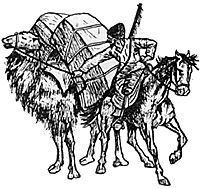 Part 2: Fight at Johnson's Crossing
Part 2: Fight at Johnson's Crossing
More ideas from Johnson's Crossing
The level of complexity of a skirmish game depends on the number of figures being used. The more figures being used the simpler the rules need to be and this is achieved in a number of ways.
The main method is to reduce the amount of personalization. Instead of giving each man his own set of ability factors, it is necessary to give all men of one experience rating the same ability factor in the two types of ability, firing and fighting. So: All Novices have an ability of 2; Averages have an abiIity of 5; Veterans an ability of 8.
It wilI also help if a man's experience rating can be discovered purely by looking at the figure. Some differentiation between types can usually be achieved quite simply. Eg:
- ZULUS
- Novices have black shields.
Averages have black and white shields.
Veterans have white shields.
BRITISH
- Novices are clean shaven.
Averages are not NCO's but are not clean shaven.
Veterans are alI NCOs.
FOREIGN LEGION
- Novices have khaki kepis.
Averages have white kepis and no service stripes.
Veterans have white kepis and service stripes.
BOERS
- Novices are clean shaven.
Averages wear brown coats and are not clean shaven.
Veterans wear black coats and are not clean shaven.
A second simplification is to divide the larger force into groups based on abiIity. With Zulus this is fairly realistic but it can not be done with European troops without sacrificing a Iittle historical accuracy.
A further simplification concerns firing. Where a row of British are firing at a mass of charging natives, take the average percentage chance and use it for each man's throw, be veteran or novice. The target should be the man directly in front.
For wounds, assume any serious hit on the larger force is sufficient to put that man out for the duration of the game. A light wound will cause delay but wiII not throw the wounded figure to the ground. That way he should be able to catch up.
Efficient record keeping, particularly recording percentage chances in melee also helps enormously. Paperwork should not be dismissed as cumbersome. If it is well organised it can easily cope with these numbers.
Finally, it helps, and adds greater pleasure and realism to the game, if the number of players involved can be increased. The Johnson's Crossing game was played in the first instance with two players but a second time with three British players and ten Zulu players It is not therefore impossible to fight relatively large games with the Colonial Skirmish Rules. As long as a one-to-one situation applies, these rules with their percentage firing and melee systems can cover all possible incidents. Try it and see. We would appreciate your comments for inclusion in a future issue.
Back to Table of Contents -- Wargamer's Newsletter # 153
To Wargamer's Newsletter List of Issues
To MagWeb Master Magazine List
© Copyright 1974 by Donald Featherstone.
This article appears in MagWeb (Magazine Web) on the Internet World Wide Web.
Other military history articles and gaming articles are available at http://www.magweb.com